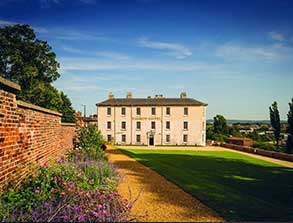
Burghley House
Built and mostly designed by William Cecil, Lord High Treasurer to Queen Elizabeth I, between 1555 and 1587, the main part of the House has 35 major rooms on the ground and first floors.
There are more than 80 lesser rooms and numerous halls, corridors, bathrooms and service areas. The lead roof extends to three quarters of an acre, restoration and rebuilding of which began in 1983 and took nearly ten years to complete. Visitor facilities include the Orangery restaurant, gift shop, gardens and beautiful walks around the historic parkland laid out by Capability Brown and still occupied by a herd of fallow deer.
History can come alive in a single trip whether it is to enjoy a guided tour, take a dog for a walk in the park, take the children to paddle, see the teddy bear’s picnic in the gardens of surprise or take time over lunch in the Orangery.

Fotheringhay Castle
After the manor came into the possession of Edward III, he passed it to his son Edmund of Langley, 1st Duke of York, founder of the Yorkist line. The castle then became the home of the Dukes of York. Richard III was born there in 1452 and his father, Richard Plantagenet, 3rd Duke of York, was re-buried at the nearby church in 1476. His wife, Cecily Neville, Duchess of York, was later interred in the same tomb. The tomb opposite contains the body of Edward, the 2nd Duke of York, who was killed at the Battle of Agincourt.
Fotheringhay is also where Mary, Queen of Scots, was tried and beheaded in 1587, and her body lay there for some months before its burial at Peterborough Cathedral and then to internment in Westminster Abbey. Although it is often said that James I destroyed the castle because his mother was killed there, the facts are rather more prosaic – it fell into such disrepair that it had to be pulled down and the stones were all taken to be used in other buildings. Local legend has it that the staircase from the castle is now in the Talbot Hotel in Oundle.

Rockingham Castle
Less than 12 miles from Market Harborough and built under the instruction of William the Conqueror around 1070, this remarkable Norman castle was held by the crown until 450 years ago when it was relinquished as a royal castle and occupied by the Watson family.
You can tour the castle grounds, starting in the old kitchen, which has been restored to resemble how it would have looked in 1895 and shows the preparation of a grand dinner. You can also explore The Panel Room, which was once used as a royal fortress and the Long Gallery, where Charles Dickens, a regular visitor to the castle, is thought to have performed during the 1850s.

Rutland Water
This internationally famous nature reserve is managed by the Leicestershire & Rutland Wildlife Trust in partnership with Anglian Water and provides one of the most important wildfowl sanctuaries in Great Britain, regularly holding in excess of 25,000 waterfowl.
It is a Site of Special Scientific Interest designated as a European Special Protection Area and internationally recognised as a globally important wetland RAMSAR site.
Get in touch
Sign up for our latest news and special offers
Book now and get our best rates
Stay in one of our rooms
Enjoy a meal in our restaurant
Book a table bigger than 10
Treat someone you know





































